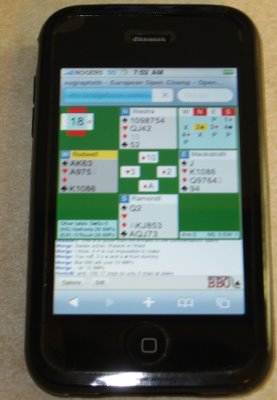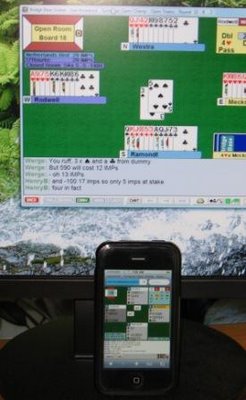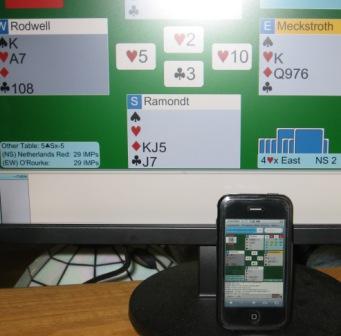The Board
It was a stunning comeback, the ten boards in the middle of the last set were wild, and the focal point was "The Board" - this amazing board is already being discussed on BBO forums (as a lead problem), and I really don't need to blog about it, as you will see it all over the net, and then in any newspaper that has a bridge column, and in all the best bridge magazines.
It was the round of 32 in the trials for USA2, and the Diamond team faced the Ozdil squad in a match that would send one of them home. Ozdil (Melih Ozdil, Jiang Gu, Xiaodong Shi, Mark Lair, Jonathan Weinstein, David Yang) had been playing since the start of the round robin. In the round of 32 for the USA1 spot, they had beaten Lewis, and then Ozdil had overcame the strong Jacobs squad in the USA1 Round of 16, and finally lost to Fleisher in the USA1 quarterfinals, which put them in this USA2 match. Diamond (John Diamond, Eric Greco, Fred Gitelman, Brian Platnick, Geoff Hampson, Brad Moss) had been seeded into the USA1 round of 16, lost to the Rogoff team, won their USA2 Round of 64 match against Beatty, before getting to this match.
After three quarters, Diamond led 118-80 (USBF line score, vugraph gives 114-80). After three pushes, board 49 had both tables in game by South:
Hampson in 3NT got a club lead, won by the jack, and declarer worked the majors to get 9 tricks in.
In the other room NS tried the 4-3 fit, and declarer almost brought it in, but having to make expensive overruffs had him run out of the necessary trump spot cards.
The Diamond team were now ahead 128-80 with 11 boards to play. On the next board both tables got to 3NT.
Against Ozdil, where Lair had bid 3S to show short spades, three hearts, and both minors, Hampson led a heart honor, ducked, and continued with the other heart honor. When North got in with a diamond, he played the heart king, assuming his partner had better hearts for the lead. After establishing a second diamond, and a with a later club finesse, declarer had 3Ss+2Hs+2Ds+2Cs for 9 tricks.
At the other table, Gitelman-Moss use the 2D transfer to show hearts, or to show a game force with both minors (2S showed this, 2NT was no minor, 3D showed longer clubs). North aggressively doubled 2D to get a diamond lead, and EW didn't have the machinery to play 2DXX, instead reaching 3NT.
South led a diamond to the queen, and North switched to the spade jack, won by declarer. The club jack was covered by the king and ace, and now Moss could play a club to the 9 - if South wins this declarer has 4Cs+3Ss+1D+1H at least, while if South ducks this declarer has 3Cs+3Ss+2Ds+1H at least. Instead Moss played the club queen from dummy, and the bad club split meant the play was a mess. He misread the end position, partly to the double on just 4Ds, and was down 1 for 10 IMPs to Ozdil,
And now
The Board:
In the Open Room Gitelman and Moss got to 6H. I'm not sure what 4NT was - it might have been intended to show long diamonds and secondary clubs, but used here to deflect South from leading clubs against 6H. It could have been some form of Blackwood, but it had a void, and Moss's reply to 4NT doesn't look like a Blackwood reply of some sort. Against 6H, a club lead would get +100, anything else -1460. Instead South bid 6S, a phantom sacrifice if he would have led a club, and gave up -1100. How many IMPs were on the line for that -1100, instead of +100, or -1460?
The answer is not many.
In the Closed Room, Lair opened 2C with playing tricks, and the auction quickly reached the grand. Greco doubled, and later told the table he was hoping that this might steer West into bidding 7NT if some other hand was held. Instead East redoubled, and South had to lead. Double equals dummy's first real bid suit, right? South led a diamond, and was -2940. He told the table he was leading a spade if no double. 1840 was 18 IMPs. 3040 (2940 + 100) would have been 22 IMPs. 1480 (2940-1460) would been 16 IMPs.
The next board was 5 IMPs to Ozdil for 2H making against 2H down 1, the key play being Ozdil ducking a first diamond play with Axx, and able to later give partner, who had xx, a ruff.
Then on the next two boards, just 1 IMP to Ozdil for an overtrick, one board being a 21 point 4S game, the other a 29 point 6S slam. This match was not about being conservative.
Next on board 55, in Open Room, Gitelman and Moss settled into 4C, down 1. North had bid 2H over West's double to show a good raise to 2S, only 6 points but it was shapely.
In the Closed Room, the same 2H bid (here, described as a constructive spade raise), found East taking a shot a 3NT, and South taking a two-way flyer at 4S - it might make, and it might be a decent sacrifice.
Lair pulled out a X to give this contract a big ticket for speeding. -800 was 14 IMPs to Ozdil, now with a small lead in the match.
Board 55 found both EWs in 1NT, doubled of course in this match. Yang led a heart away from AQxxx and got -300, while Greco tried a diamond from J94, and the tempo cost a trick, just -100, and 5 IMPs to Ozdil.
On the next board, both tables were in 3NT. In the Closed Room, it was by East, and it was down 2 on a diamond lead.
Hampson remarked to Lair that 3NT would make from his side, and Gitelman tried that in the other room.
On a heart lead by North, Gitelman ducked in dummy, which seems natural, but now South won the heart king, and fired back a diamond. Again Gitelman ducked an ace, and South played another diamond to sink the contract. Still down only one was 3 badly needed IMPs back to the Diamond team.
Next came the final nail. In the Closed Room it looked like the stop in 3NT with 31 points would work, with the red suit honors not well placed.
However 3NT made 6 on a high diamond lead by West. In the Open Room they reached 6NT:
Generally I like passive leads against 6NT and 7 level contracts. However the score at the start of the set, and 6SX for 1100 at this table seemingly a phantom sacrifice, and the auction, gave it the reek of a shot at slam, and Gitelman went with a high diamond lead. He lost the first diamond trick to the ace, took the diamond ten with the queen at the second trick, and returned a diamond. With the bad spade split, declarer had 4Ss+3Ds+3Ds+1H. However West had to keep a spade, East a club, and thus neither player could guard hearts when the hand was played out (follow the cards with handviewer if you want to see how it all worked). The double squeeze was worth 13 IMPs for the victory. It was a stunning set of ten boards.
 .
. .
. .
.